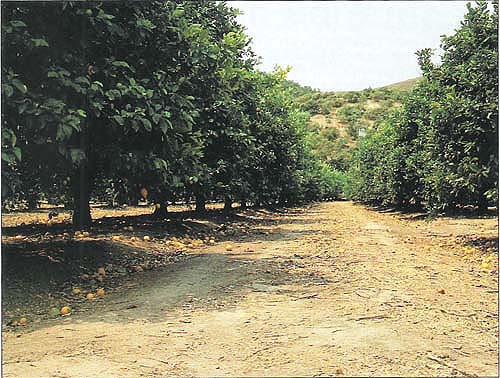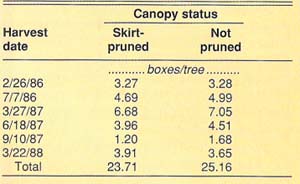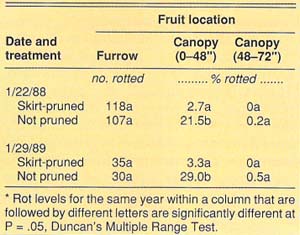All Issues
Citrus skirt pruning – a management technique for Phytophthora brown rot
Publication Information
California Agriculture 44(6):6-7.
Published November 01, 1990
PDF | Citation | Permissions
Abstract
Trials in Ventura and Tulare counties now establish that skirt-pruning can significantly reduce Phytophthora brown rot damage to lemon fruit without harming fruit yields.
Full text
By pruning all branches 18 inches from the orchard floor, citrus growers can prevent damage from snails and some insects. New research shows this practice also helps reduce Phytophthora brown rot on lemon fruit without reducing overall fruit yields. Phytophthora-infected lemon fruit (facing page) is discolored, rotten, and unmarketable.
For management of snails, honeydew-seeking ants, the Fuller rose beetle, and several other citrus pests, pruning the canopy skirts of citrus trees has become an accepted tactic in southern California citrus growing areas. Until now, no information has been available on the possibility this tactic might harm fruit yields or the possibility it might help manage Phytophthora brown rot on lemon fruit. Other researchers have determined that skirt pruning has no significant impact on yields of Valencia or navel oranges. We conducted two studies: one to determine the impact of skirt pruning on lemon yields, and another to test the hypothesis that skirt pruning could reduce the incidence of fruit infection with Phytophthora citrophthora (brown rot) on tree skirts.
Methods
The yield study took place in Ventura County on the Limoneira Ranch between February 1986 and March 1988. The site was an 18-acre lemon orchard (Limoneira 8A on Macrophylla rootstock) with eight plots; four replicates of skirted and unskirted trees alternated across the orchard. Each replicate averaged 87 trees long and four rows wide, with two rows on either side of a picking drive to make it easier to record the yield data. The skirt-pruned plots were pruned on July 2, 1985, December 8, 1985, July 9, 1986, and July 7, 1987 to maintain the tree skirts 12 to 18 inches above the orchard floor. At each harvest, we recorded the number of field boxes harvested from each plot. On three occasions, all the fruit from each treatment were sent to the packing house where they were graded according to standard grading procedures.
After two relatively dry winters in Ventura County (1985 and 1986), the development of brown rot did not differ significantly for the two treatments. We subsequently moved the Phytophthora study to Tulare County in the San Joaquin Valley. The new test site was a 30-acre lemon orchard on Allied Farming's Paramount Ranch. We divided the site into four 8-acre blocks. The orchard had water mist sprayers for frost protection, and had a history of chronic problems with Phytophthora brown rot.
One skirt-pruned plot of eight trees and one unpruned plot of eight trees were located in each of the four blocks, for a total of eight plots. The rest of the trees in the orchard were not skirt-pruned. The study spanned two winters, from September 1987 through January 1989. The skirt-pruned trees were pruned early in November 1987 and 1988. By mid-January 1988 and 1989, fruit infected with brown rot were so abundant that we could make counts of Phytophthora-infected fruit on each of the eight sample trees in each plot. We also conducted in-furrow counts of dropped and rotted fruit within the tree's drip line to account for Phytophthora citrophthora lesions around the stem area, which result in fruit drop. In addition, we counted the infected fruit on the tree at three heights: 0 to 48 inches, 48 to 72 inches, and above 72 inches in the tree canopy.
TABLE 3. The influence of soil sample depth on Phytophthora citrophthora inoculum levels, Tulare County site
TABLE 4. Phytophthora brown rot levels at different levels below and within the tree canopy for skirt-pruned and unpruned trees*, Tulare County site
Results
While complementary, the lemon yield and Phytophthora brown rot aspects of this skirt-pruning study are not dependent upon one another. For this reason, we will present and discuss the results from the two test sites as elements of an overall comprehensive study on the role of skirt pruning in citrus pest management.
In the yield study at Ventura County, skirt pruning did not significantly reduce yields over the course of the 2-year study (table 1). Since fruit on unskirted trees tend to sustain more snail damage and general abrasions from contact with the orchard floor and orchard equipment, we expected that skirted trees might show some improvement in fruit quality. This study, however, showed only a slight improvement in fruit quality in the skirted plot (table 2).
During our first year of the Phytophthora brown rot study at Tulare County, 10- to 12-inch soil samples for Phytophthora citrophthora (standard for P. parasitica soil sampling) showed a poor correlation between soil inoculum levels and fruit infestation levels. We investigated a shallower sampling technique in 1988-1989. Sample depths of less than 6 inches gave the greatest recovery of P. citrophthora (table 3).
In both 1987-1988 and 1988-1989, Phytophthora brown rot incidence was significantly greater (P=0.5) within48 inches of the ground in plots that were not skirt-pruned than in those that were (table 4). In neither year did the counts of rotted fruit in the furrow differ between treatments. Neither in 1987-1988 nor in 1988-1989 were many P. citrophthora lesions observed higher than 48 inches into the tree canopy. However, for both years only the unskirted plots had any P. citrophthora infections between 48 and 72 inches, though the number of these infections did not constitute a statistically significant difference from the skirt-pruned treatment. In neither treatment were any P. citrophthora infections detected higher than 72 inches into the tree canopy for either year.
Conclusions
Lemon trees can be skirt-pruned with no significant loss of yield. Skirt-pruning lemon trees can reduce the percentage of fruit infected with brown rot.










